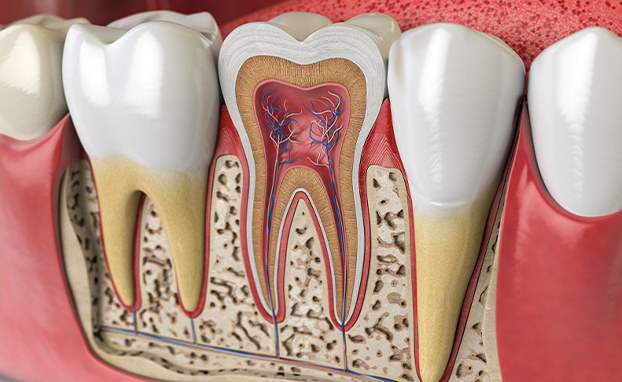Root Canal Treatment

Root Canal Treatment
Exploring the Basics of Root Canals
The center of a tooth contains pulp, which is made up of blood vessels, nerves, and connective tissue. If the pulp becomes injured or infected, it can lead to swelling, infection, and pain. Even without obvious symptoms, bacteria in the root canal can cause decay and harm to the jawbone. In such cases, a root canal procedure may be needed to save the tooth.
A root canal can remove the infected pulp to prevent further problems. Various issues, such as repeated dental work on the same tooth, cracks, deep cavities, or injuries, may require a root canal. Signs that a root canal may be necessary include bumps along the gums, darkening gums, severe pain or sensitivity while biting or chewing, and swollen or tender gums. It's important to note that symptoms of root canal infection or injury may not always be clear, and a thorough examination may be needed for diagnosis.
“A root canal can remove the infected or inflamed pulp to prevent further issues.”
Benefits of Root Canal Treatment
- Improved appearance: After root canal treatment, the patient will receive a crown or filling that restores the tooth’s aesthetic appearance.
- Reduced risk of further decay: Removing the infected dental pulp prevents bacteria from spreading and damaging surrounding teeth.
- Restored function: Root canals restore a tooth’s health, allowing it to function like any other tooth.
- Saving the natural tooth: Nothing can replace the look and function of a natural tooth.
“ The goal of root canal treatment is to save and preserve the natural tooth.”
Root canal treatment and complications.
Healthline explains that root canal treatment usually consists of four steps. Initially, an X-ray will be taken of the infected tooth and the treatment area will be numbed. A dental dam will then be placed over the area to protect it from saliva and bacteria during the procedure. Following this, a small incision will be made near the tooth's crown to expose the infected pulp, which will then be removed and the pathways cleaned. After the canals are cleaned, a topical antibiotic may be applied to eliminate any remaining infection. The tooth will then be filled and sealed, and a crown or other restoration will be placed to protect the tooth and restore its function.
While root canal treatment does come with risks, such as the possibility of the damage being too extensive for treatment to be successful, resulting in tooth loss, or the rare occurrence of abscesses if the infected pulp is not properly removed or if antibiotics are ineffective, it is generally considered safe and effective. The success rate of root canal treatments is typically between 86-98%.




